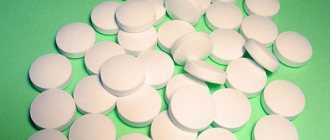Release form of Smecta and its chemical composition
The active substance of Smecta is aluminosilicate, combined with magnesium silicate. Auxiliary components give the medicine a pleasant sweet taste. This -
- dextrose monohydrate - 749 mg;
- sodium saccharinate - 7 mg;
- vanillin - 4 mg.
The antidiarrheal drug is offered in powder form, packaged in laminated paper bags. Each leakproof pouch contains 3.76 grams. The bags are packaged for sale in cardboard boxes of 10 or 30 pieces.
Mechanism of action of Smecta
Smecta has an absorbent effect. Diosmectite molecules dissolved in liquid form multivalent bonds with glycoproteins of mucus that forms on the walls of the gastrointestinal tract. The volume of mucus increases, it envelops the intestinal walls, thereby preventing the absorption activity of the mucosa. Thus, the absorption of hydrochloric acid, bile salts, microorganisms and toxic products of their vital activity slows down, and the cytoprotective properties of the mucous membrane against hydrogen ions are improved.
The active ingredients of Smecta are also not absorbed from the gastrointestinal tract, but are excreted through the intestines, therefore Smecta during lactation does not penetrate into the blood and milk of a nursing woman, and does not harm the baby during breastfeeding.
In doses recommended for use, Smecta does not affect the contractile activity of the gastrointestinal tract, does not enter into chemical reactions with digestive products and is excreted through the intestines.
Positive properties
The substance helps to quickly and effectively restore intestinal function. The component is characterized by excellent viscosity, so it completely dissolves in water within a few seconds.
When breastfeeding, Smecta has a positive effect on the human body:
- qualitatively and quickly envelops the mucous membrane, thereby eliminating the effects of toxins and other harmful substances;
- the microflora is restored, so the intestines can continue functioning as before;
- a protective barrier is formed in the intestines, which helps a person get rid of gases;
- the effective composition completely absorbs harmful substances and quickly eliminates them naturally;
- improves the protective functions of the gastrointestinal tract;
- restoration of all necessary microflora components;
- the intestines become more resistant to the effects of toxins and waste.
The drug helps to cope with stomach and intestinal problems during breastfeeding
A woman can drink Smecta, as it helps get rid of viruses and bacteria. These microorganisms negatively affect the intestinal mucosa. The drug consists of mineral components. They help improve the composition of microflora. The advantage of the drug is also the presence of an adsorbing effect. Thanks to this, the substance tends to work selectively.
It is recommended to drink Smecta if you have problems with the digestive system. However, it is recommended to consult your physician before use. He will help you decide on the dose and evaluate the advisability of taking it.
Directions for use and dosage
Smecta for the treatment of adults is diluted at the rate of 2 sachets per half glass of water. The patient takes this solution 3 times a day. When taking 3 sachets daily, they are all diluted in a glass of water, and the solution is divided into three doses, drunk one and a half to two hours after meals.
For infants, the powder is diluted in 50 ml of milk, warm boiled water and given throughout the day. You can also add the drug to semi-liquid foods (porridge, baby food, purees).
How to dose the drug before drinking it is shown in the table.
| Age→ | For adults | Children under 1.5 years old | Children over 1.5 years old | Notes Additions |
| Condition, pathology ↓ | ||||
| Acute diarrhea | It is recommended to dilute 2 sachets per dose. That's a total of 6 sachets per day. | 2 sachets per day - the first 3 days, and then 1 sachet | 4 sachets – for 3 days and then 2 sachets per day. | Taken between meals |
| Dyspepsia and its symptoms | 3 sachets per day | 1-2 sachets per day | 2-3 sachets per day | Course of treatment 3-7 days |
| Esophagitis | The drug is taken after meals. |
Indications
The use of Smecta is indicated for the following diseases:
- Acute or chronic diarrhea resulting from food poisoning, allergies, or poor diet.
- For diarrhea accompanying an infectious disease.
- For pathologies accompanied by digestive disorders: heartburn, flatulence, abdominal discomfort.
Young mothers are concerned about whether a nursing mother can take Smecta? Most antibiotics and other drugs that normalize the activity of the gastrointestinal tract are not safe for infants, and Smecta remains almost the only drug with a gentle mechanism of action.
Breastfeeding and infancy are not contraindications for treatment with smecta. Smecta can be given even to infants.
It is important to know that Smecta reduces the absorption of medications (antipyretics, antibiotics, etc.), therefore, taking Smecta for a long time, other drugs are better taken by injection. On the one hand, this will reduce the load on the gastrointestinal tract, and on the other, it will increase the effectiveness of treatment.
How to take Smecta correctly when breastfeeding
Professional skills: Colon hydrotherapy, treatment of gastrointestinal diseases
Many medications should not be taken during breastfeeding. Conventional drugs pass into the milk and are thus passed on to the baby. Accordingly, a nursing mother is either given medications that are not absorbed into the blood, or the woman refuses to feed the baby during treatment.
Smecta is used during breastfeeding to treat gastrointestinal diseases, as it belongs to the category of enveloping drugs.
Contraindications and side effects
The following pathological conditions are contraindications to the use of Smecta:
- Intestinal obstruction.
- Glucose-galactose malabsorption.
- Allergy to fructose.
- Increased susceptibility to diosmectite.
In general, Smecta is well accepted by the body. Side effects are rare. For example, the occurrence of constipation can be corrected by reducing the dose of the drug. There are, however, rare cases of allergic manifestations: rash, itching, symptoms of urticaria, and suffocation. In this case, it is necessary to replace the device with an analogue that does not contain Smecta components.
Analogues of Smecta
This list contains only those drugs that can be used during breastfeeding.
- Activated carbon is a black tablet made from charcoal. Contraindications for the use of activated carbon are ulcerative lesions and bleeding from the gastrointestinal tract.
- Enterosgel is a paste for oral administration. The active substance is polymethylsiloxane polyhydrate. Contraindicated for intestinal atony (impaired motility).
- Enterodes – powder for suspension. The active substance is polyvinylpyrrolidone. The use of the drug is not permissible for acute nephritis, bronchial asthma, and heart failure. Pregnant women and nursing mothers should use this drug with caution.
- Enterofuril - suspension or capsules. The active ingredient is Nifuroxazide. The only contraindications are intolerance to the components of the drug or an allergic reaction to them. In general, it is well tolerated and is prescribed even to premature infants.
Smecta is produced under the following trade names: Neosmectin, Diosmectite, Dioctahedral Smectite, Smecta. The price of the package depends on the dosage form (powders, suspension), manufacturer and region. The drug costs from 70 to 170 rubles.
Features of taking the drug during breastfeeding
A woman should carefully study Smecta’s instructions before using it directly. The drug can be used to improve the functioning of the digestive system during lactation. Nursing mothers should follow the dosage exactly. Otherwise, the risk of harm to the baby’s body increases.
We recommend reading: Duphalac during breastfeeding and reviews about it
The drug must be taken one hour before meals. It is also possible to use the medicine an hour after eating.
At least two hours should pass between two doses.
To treat poisoning, it is allowed to drink no more than six sachets per day.
The course of treatment depends on the individual characteristics of the body and should not exceed seven days.
Smecta is made from natural ingredients. That is why it is allowed to drink during pregnancy and lactation.
This will not have a negative effect on the child’s body.
The drug cannot penetrate into the blood and breast milk. It affects exclusively the mucous membrane of the intestines and stomach. To date, there have not been any cases of allergies in mothers or children. Despite all the benefits, you should consult your doctor before using the medicine.
Smecta will restore normal stool
Smecta is a drug that has a number of contraindications. A woman is advised to familiarize herself with them before using it.
The medicine helps a woman get rid of:
- colic in the intestines;
- severe heartburn that occurs after eating;
- removes gases naturally;
- eliminates infection from the intestines;
- comprehensive elimination of problems with the digestive system;
- normalization of stool.
You should avoid taking Smecta in the following cases:
- presence of allergies to the components of the drug;
- production of insufficient amounts of enzymes;
- there is an obstruction in the intestines;
- The body cannot absorb fructose.
Reviews
Inna Ivanovna, pediatrician. Novgorod:
Smecta is well accepted by the body if you do not violate the instructions for its preparation. Children even love its sweet vanilla taste. Smecta is better accepted than activated charcoal and has a more gentle effect on the mucous membrane, but it should be taken if you have diarrhea. With normal bowel movements, taking Smecta can lead to constipation.
Tatyana, young mother, Samara:
Recently I always keep Smecta in our home medicine cabinet. One day, a 2-year-old boy became infected with rotavirus. I poured the entire sachet into a 50 gram bottle and gave him the entire solution at once. The illness subsided, but there was constipation for several days. I think I overdose. I came to the conclusion that Smecta saves not only from diarrhea, but also blocks harmful microflora. I myself am saving myself from loose stools with Smecta.
- Related Posts
- Licorice root - is it possible or not while breastfeeding?
- Is it possible to Nise while breastfeeding?
- Features of using the drug Duphalac during breastfeeding
« Previous entry
Smecta during breastfeeding
After the birth of a long-awaited baby, many nursing mothers think not only about their diet, but also about taking medications, because they pass into breast milk and can negatively affect the health of the newborn. During lactation, it is very important to choose a medication that will not harm the baby. Unfortunately, there are few such drugs on the modern pharmaceutical market. Very often, young mothers ask the question: can Smecta be used while breastfeeding? This article will answer this question and tell you the features of taking and dosage of this medication.










